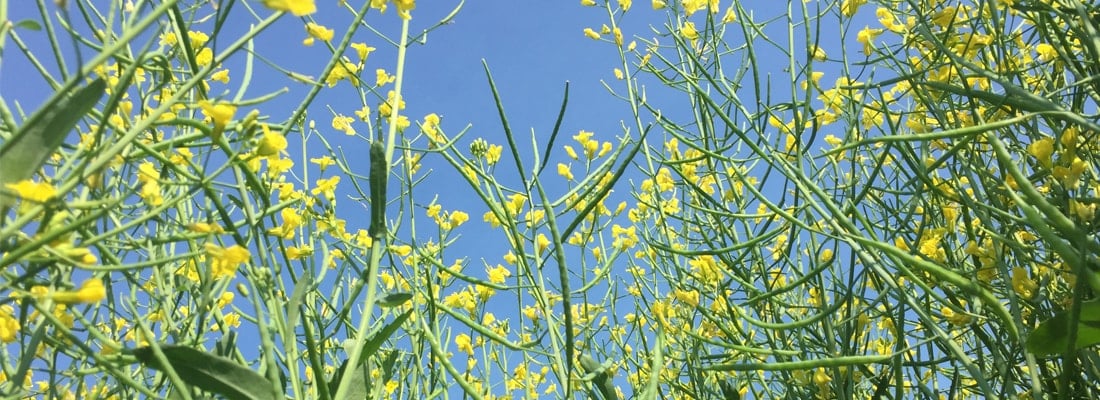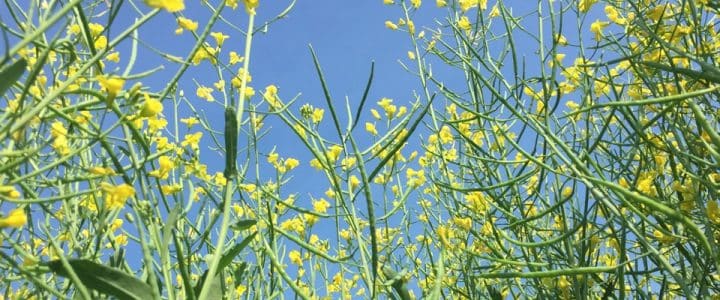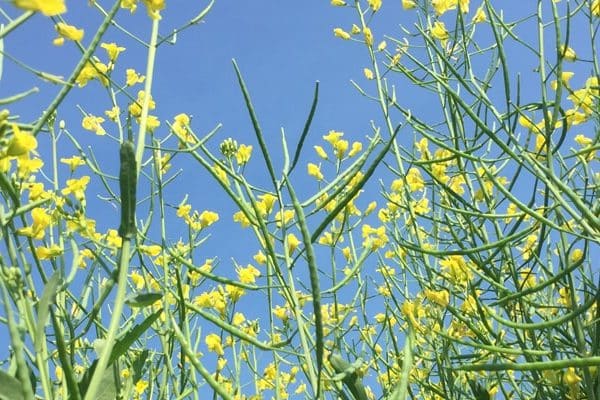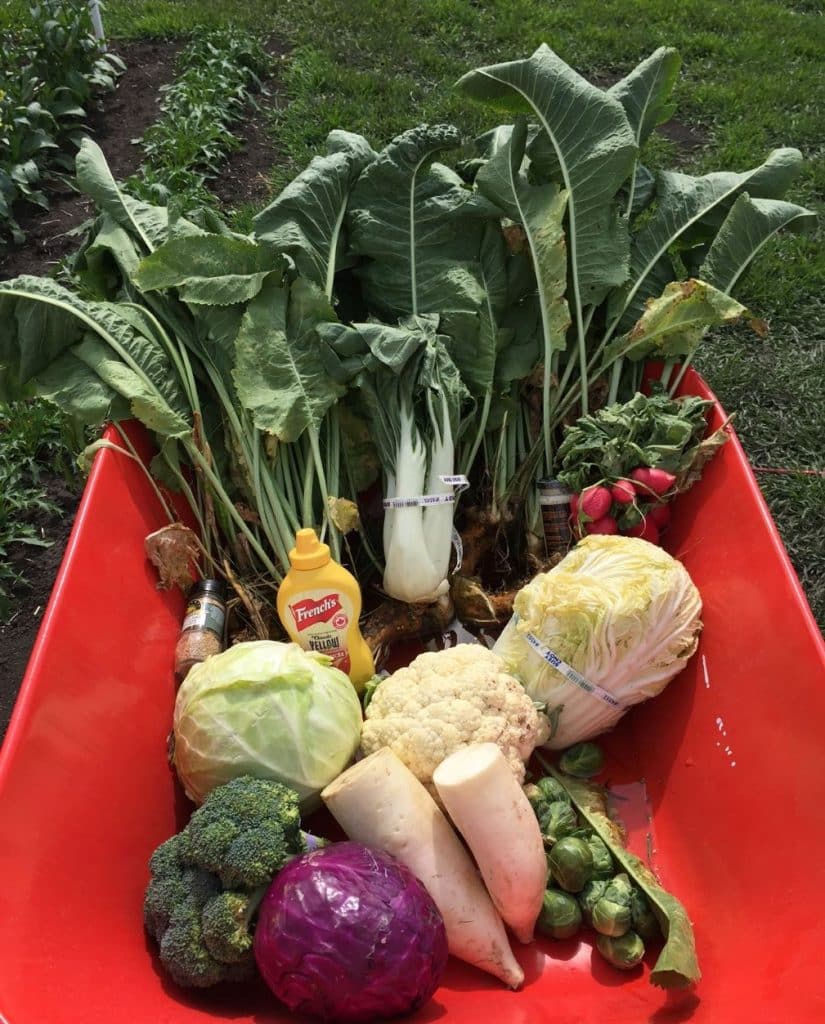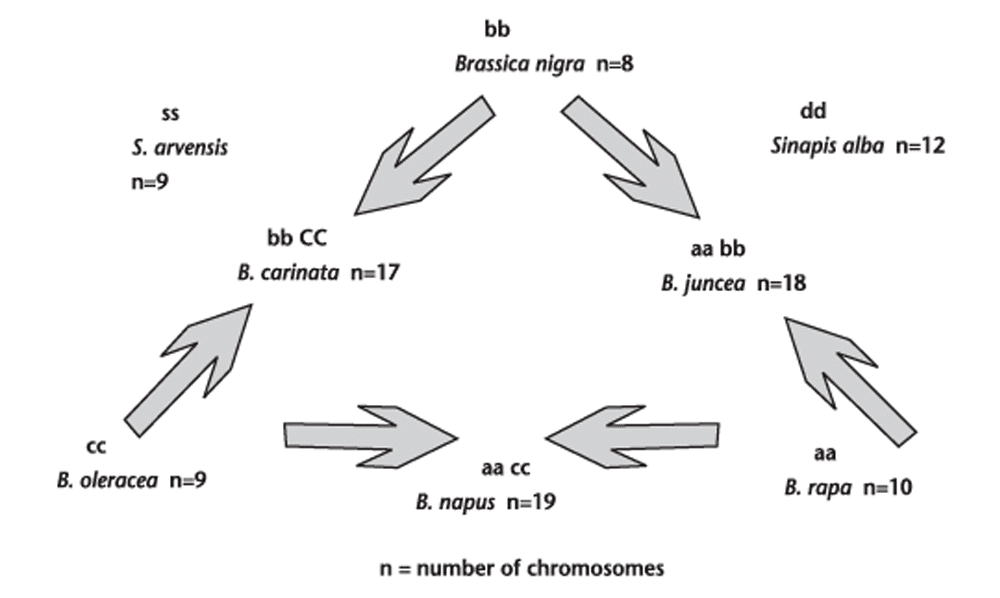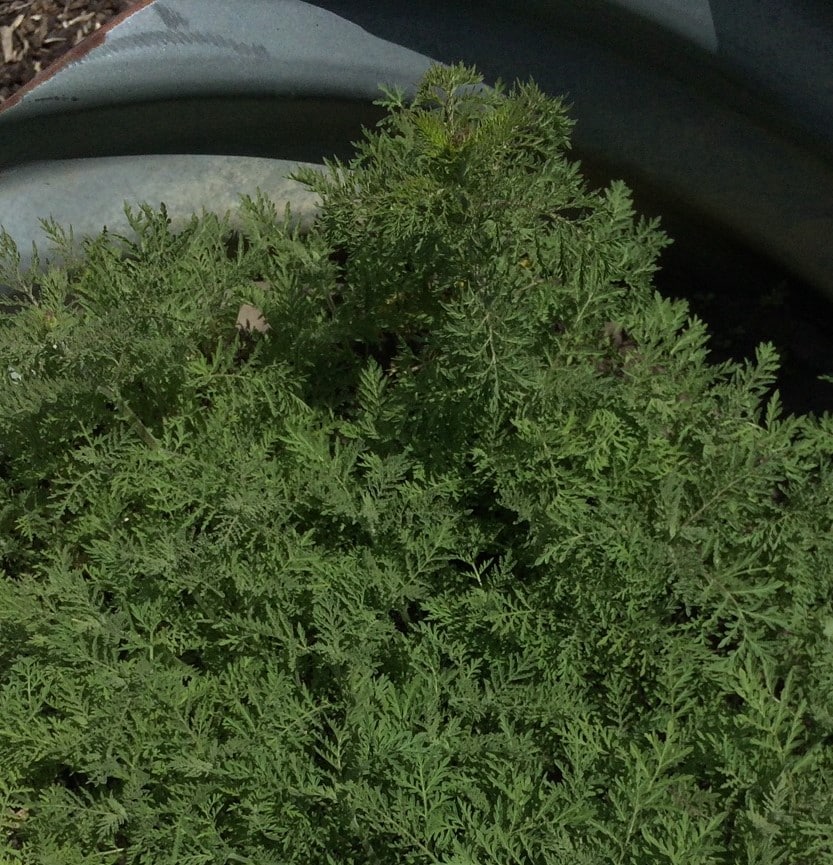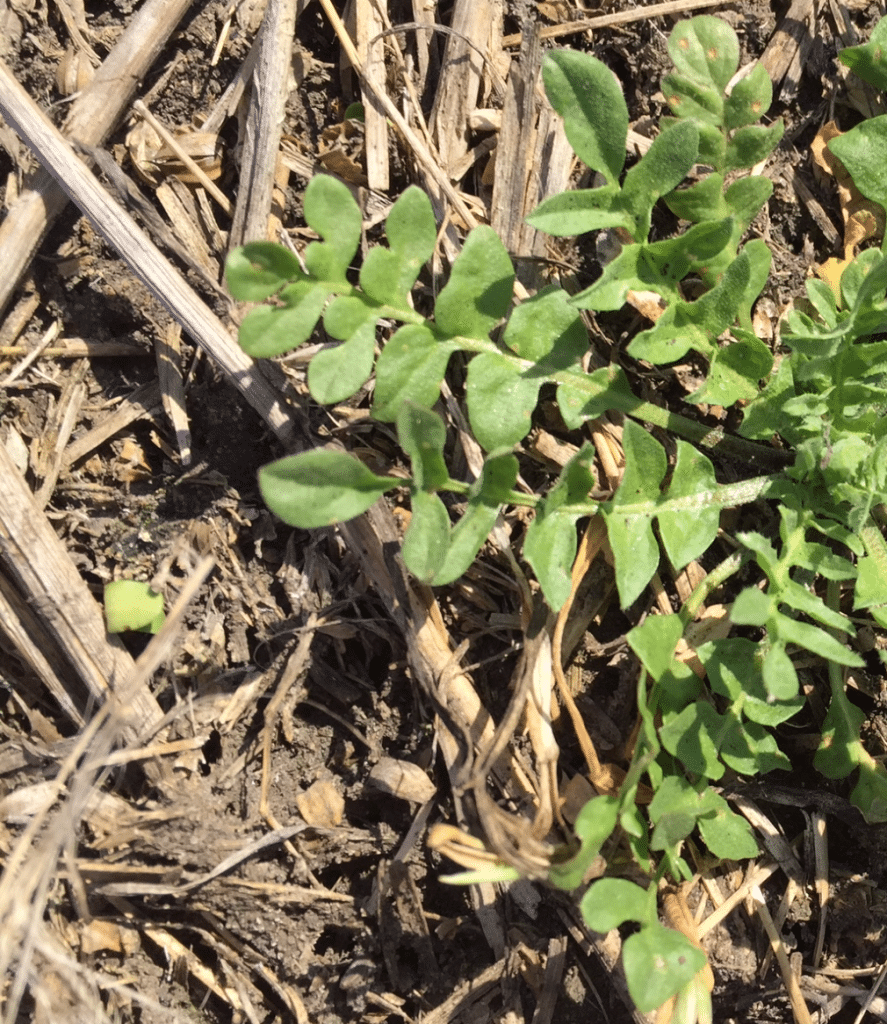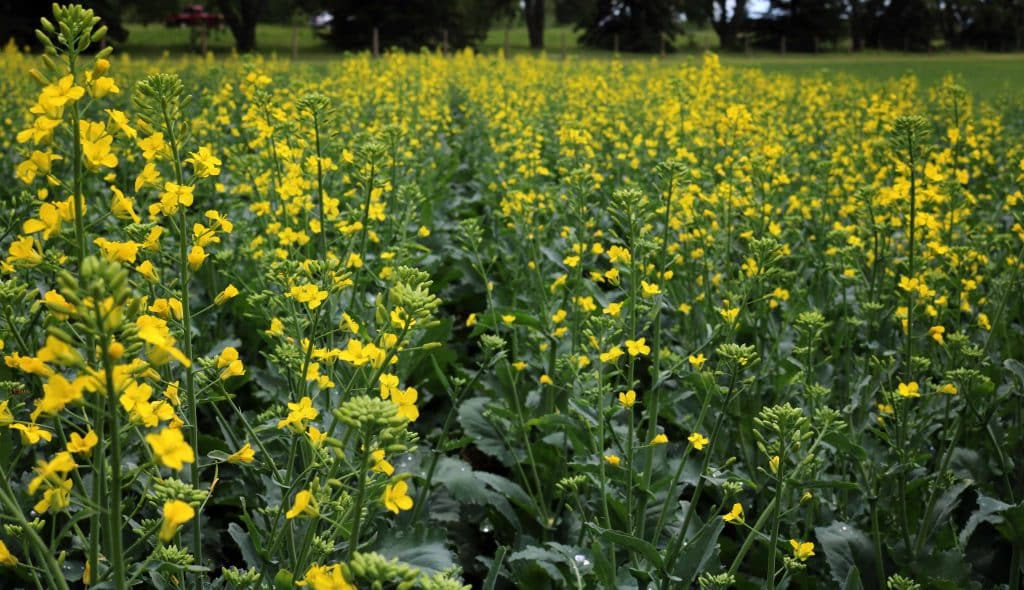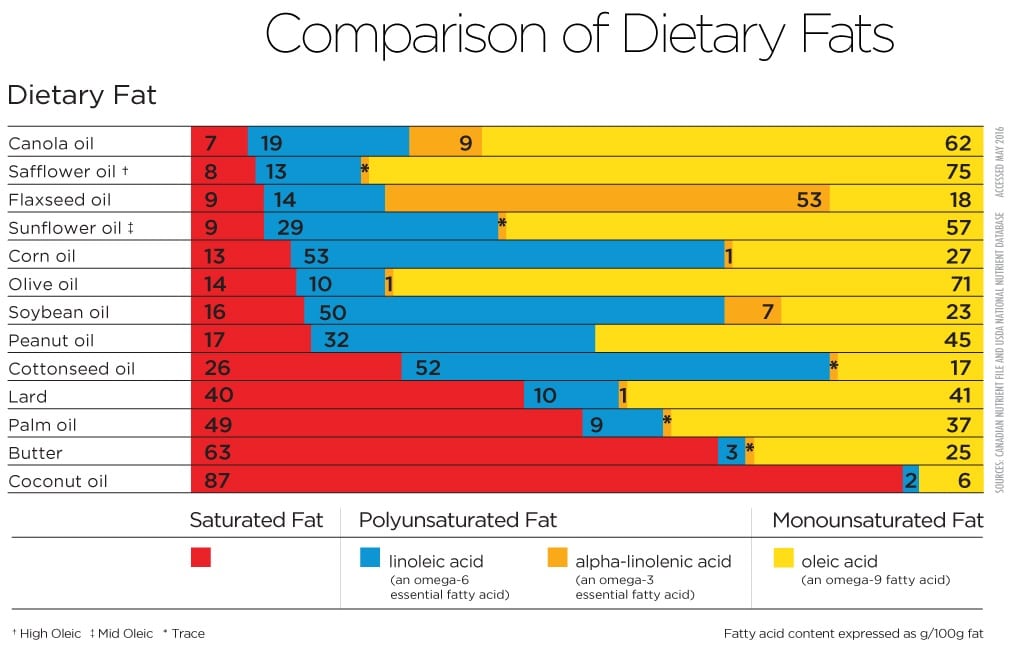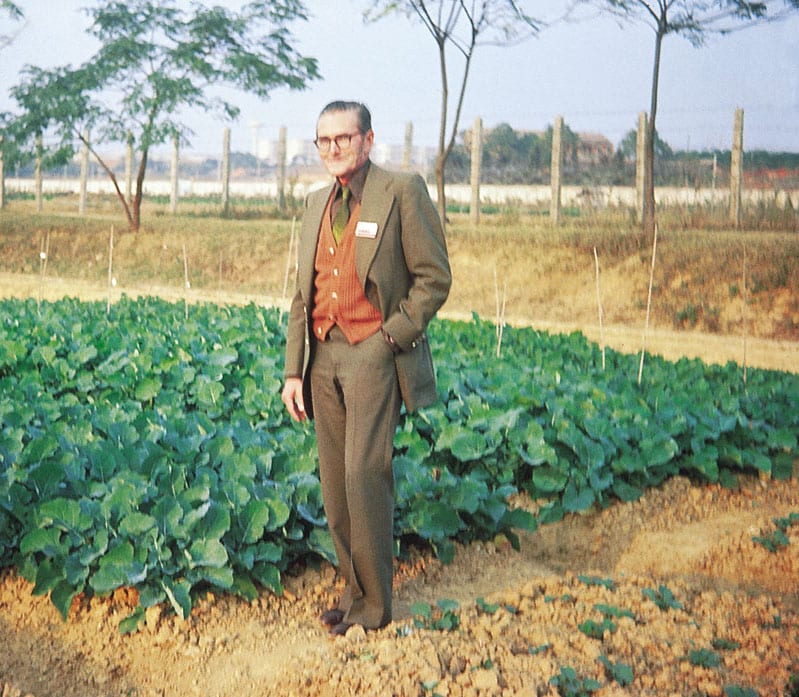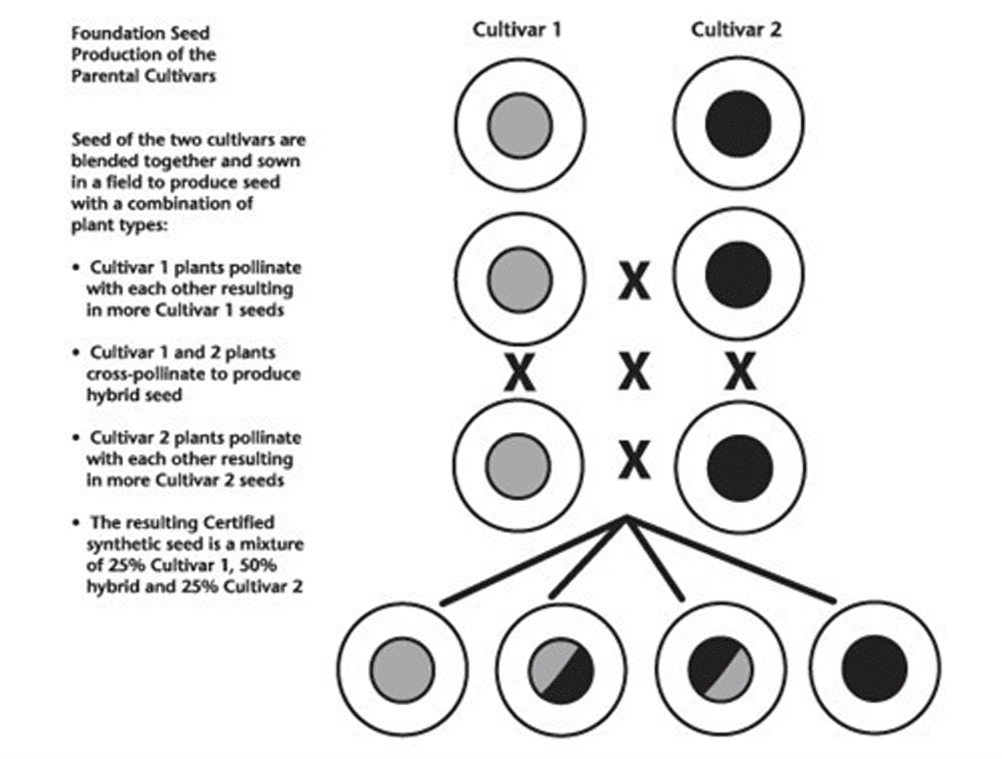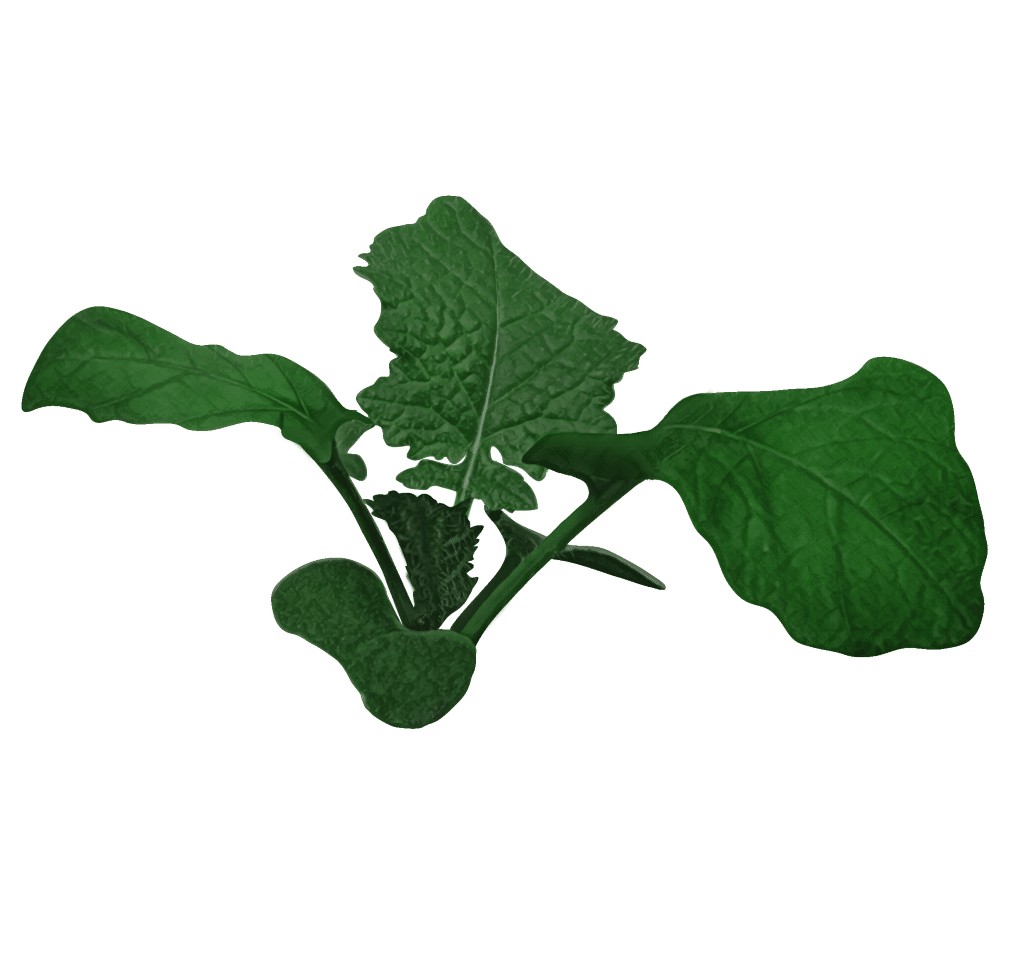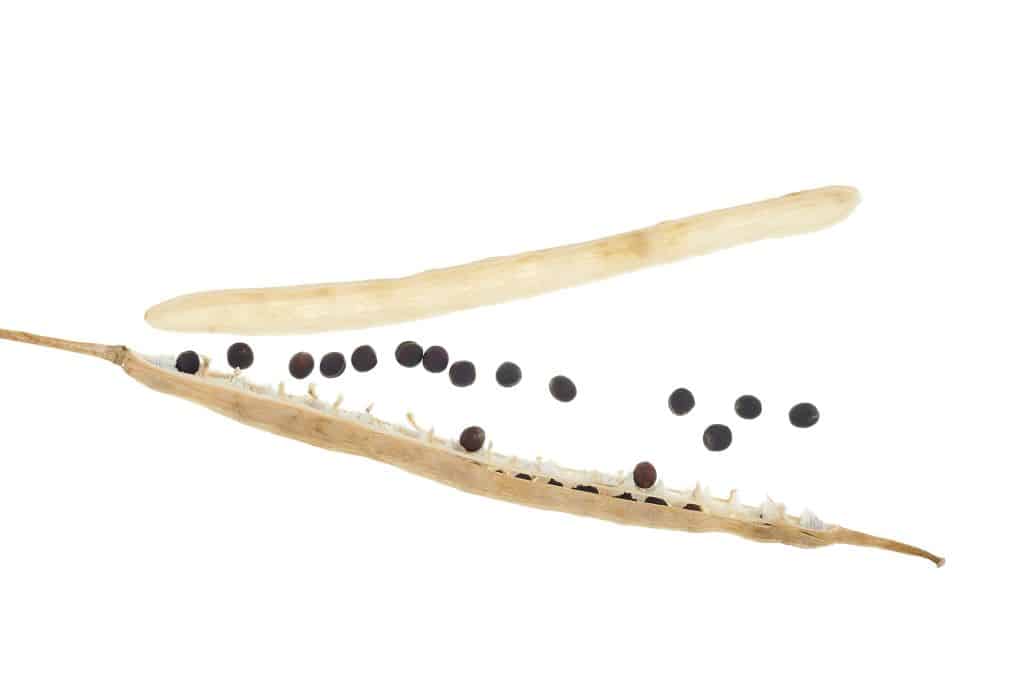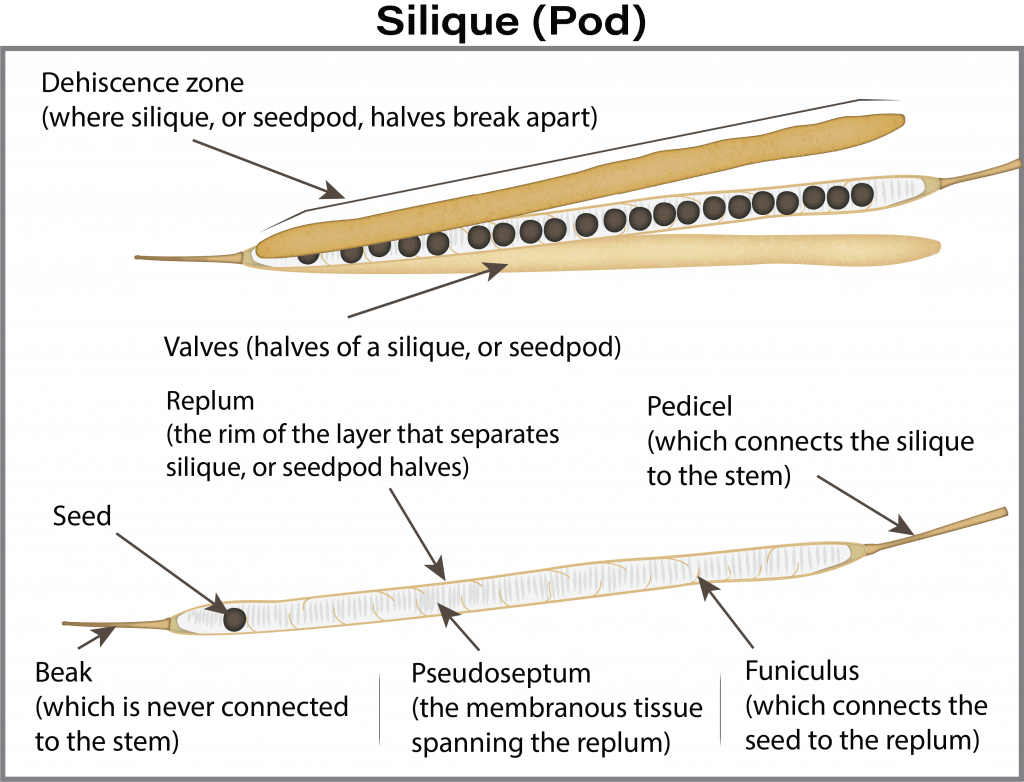Canola is a relatively new crop, and so far, is the only one “made in Canada”. Canola has become one of the world’s most important oilseed crops and is a profitable crop choice for Canadian farmers. Learn about the history of Brassica napusAlso referred to as Argentine canola, it is the species of canola currently commonly grown in Canada. More that we are familiar with today, along with cultivar improvements that have occurred as end uses, consumer preferences, and agronomic preferences have changed over time.
An interactive timeline explaining historic milestones can be found at this Canola History page.
Overview of canola seed
Canola cultivars grown in Canada belong to the Brassica napusAlso referred to as Argentine canola, it is the species of canola currently commonly grown in Canada. More, B. rapaAlso referred to as Polish canola, it is the less commonly grown species of canola currently grown in Canada. More or B. juncea species, which belong to the much larger mustard family (Brassicaceae, formerly referred to as Cruciferae). Since B. napusAlso referred to as Argentine canola, it is the species of canola currently commonly grown in Canada. More and B. rapaAlso referred to as Polish canola, it is the less commonly grown species of canola currently grown in Canada. More species were first introduced in Canada, plant breeders have developed many cultivarsCultivars are variants in a species developed through the intervention of humans (despite the term 'variety' often being incorrectly used to describe this). Cultivars can be open-pollinated type, hybrid, synthetic, composite, etc. More. The development of these cultivarsCultivars are variants in a species developed through the intervention of humans (despite the term 'variety' often being incorrectly used to describe this). Cultivars can be open-pollinated type, hybrid, synthetic, composite, etc. More, with improvements in desirable agronomic traits and oil and meal quality has influenced the rapid expansion of the canola industry in Canada, especially during the last few decades. Improved end use quality has increased the market for canola seed and its products.
In 2002, canola quality B. junceaAlso referred to as brown mustard, it is a minor crop (from the Cruciferae or Brassicaceae plant family, commonly known as the mustard family) grown in Canada. More was introduced under contract production. There are considerable differences in agronomic characteristics and seed yield among cultivarsCultivars are variants in a species developed through the intervention of humans (despite the term 'variety' often being incorrectly used to describe this). Cultivars can be open-pollinated type, hybrid, synthetic, composite, etc. More that growers carefully evaluate when choosing which one to grow on their farm. Choosing a cultivar that is best suited to local conditions (i.e. a particular farm or field) will maximize seed yield, profitability, and return on investment.
Brassica species and relatives
Canola is comprised of three species that are modified using traditional plant breeding methods forms of rapeseed or brown mustard:
- Brassica rapaAlso referred to as Polish canola, it is the less commonly grown species of canola currently grown in Canada. More or Polish canola
- Brassica napusAlso referred to as Argentine canola, it is the species of canola currently commonly grown in Canada. More or Argentine canola
- Brassica junceaAlso referred to as brown mustard, it is a minor crop (from the Cruciferae or Brassicaceae plant family, commonly known as the mustard family) grown in Canada. More or canola quality brown mustard
Until the early 1990’s, B. rapaAlso referred to as Polish canola, it is the less commonly grown species of canola currently grown in Canada. More was referred to as Brassica campestris. The difference in species name arose from an error in classification made by the 18th century father of taxonomy, Carolus Linnaeus. He named the turnip producing Brassica species B. rapaAlso referred to as Polish canola, it is the less commonly grown species of canola currently grown in Canada. More. (“rapa” being Latin for root).
Linnaeus later discovered a related plant that he believed was different from B. rapaAlso referred to as Polish canola, it is the less commonly grown species of canola currently grown in Canada. More. He gave this vegetable oil producing plant the name B. campestris. A review of his classification by taxonomists in the late 20th century found that the two plants in fact belonged to the same species and were cross fertile. Since B. rapaAlso referred to as Polish canola, it is the less commonly grown species of canola currently grown in Canada. More was the name first associated with the species, the decision was made to eliminate the use of the term B. campestris in favour of B. rapaAlso referred to as Polish canola, it is the less commonly grown species of canola currently grown in Canada. More.
Brassica rapaAlso referred to as Polish canola, it is the less commonly grown species of canola currently grown in Canada. More, B. napusAlso referred to as Argentine canola, it is the species of canola currently commonly grown in Canada. More, and B. junceaAlso referred to as brown mustard, it is a minor crop (from the Cruciferae or Brassicaceae plant family, commonly known as the mustard family) grown in Canada. More species belong to the Brassicaceae (Cruciferae or mustard) family. This family consists of about 3,000 species of plants found mainly in the northern hemisphere. The name crucifer originates from the arrangement of the plants flower petals-diagonally opposite each other in the form of a cross. Many Brassica species have been cultivated since prehistoric times for their edible roots, stems, leaves, buds, flowers, and seeds. Members of the B. rapaAlso referred to as Polish canola, it is the less commonly grown species of canola currently grown in Canada. More species include turnip, Chinese cabbage, and canola, while B. napusAlso referred to as Argentine canola, it is the species of canola currently commonly grown in Canada. More species include rutabaga and canola, and B. junceaAlso referred to as brown mustard, it is a minor crop (from the Cruciferae or Brassicaceae plant family, commonly known as the mustard family) grown in Canada. More species consist of mustard greens, various leaf mustards, and brown or Indian mustard.
Rapeseed is closely related to other Brassica species like cabbage, cauliflower, kale, and brown and oriental mustard. These relationships are important to canola plant breeders because they provide a large source of genetic material for research and development of new cultivarsCultivars are variants in a species developed through the intervention of humans (despite the term 'variety' often being incorrectly used to describe this). Cultivars can be open-pollinated type, hybrid, synthetic, composite, etc. More. Figure 1, based on the U triangle (or triangle of U) 1 outlines the relationships among Brassica species. B. napusAlso referred to as Argentine canola, it is the species of canola currently commonly grown in Canada. More, with 19 chromosomes, originated about 1,000 years ago from a cross between B. oleraceaA plant species (from the Cruciferae or Brassicaceae plant family, commonly known as the mustard family) that includes broccoli, Brussels sprouts, cauliflower, cabbage, kale and kohlrabi, amongst others. More (cabbage = nine chromosomes) and B. rapaAlso referred to as Polish canola, it is the less commonly grown species of canola currently grown in Canada. More (turnip = 10 chromosomes). The same is true for B. junceaAlso referred to as brown mustard, it is a minor crop (from the Cruciferae or Brassicaceae plant family, commonly known as the mustard family) grown in Canada. More, which originated from a cross between B. nigra (black mustard) and B. rapaAlso referred to as Polish canola, it is the less commonly grown species of canola currently grown in Canada. More (turnip).
More distantly related to rapeseed are the species Sinapis alba (white mustard) and Sinapis arvesis (wild mustard). These two species were formerly referred to as Brassica hirta and Brassica kaber, respectively. Besides wild mustard, the Brassicaceae family also contains a host of species (which are commonly perceived as pests in agriculture), including:
- stinkweed – Thlapsi arvense L.
- wild radish – Raphanus raphanistrum L.
- shepherd’s purse – Capsella bursa-pastoris (L.) Medic.
- dog mustard- Erucastrum gallicum (Willd.) Schulz
- flixweed- Descurainia sophia (L.) Webb.
- common peppergrass – Lepidium densiflorum Schrad.
- ball mustard – Neslia paniculata (L.) Desv.
The history of canola seed in Canada
Historical records indicate that rapeseed was cultivated as early as 2000 B.C.E. in India and introduced into China and Japan around 35 B.C.E. Documented use or that of a close relative appears in the earliest writings of European and Asian civilizations. Rapeseed plants prefer to grow in relatively low temperatures, with less heat required for successful reproduction than other oilseed crops. Therefore, rapeseed was one of the very few oil sources that could be successfully grown in temperate climates. This led to rapeseed being grown in Europe as early as the 13th century. In later centuries, rapeseed was used for both cooking and lighting, as its oil produced a smokeless white flame. Rapeseed had a rather limited industrial acceptance until the development of steam power, when it was discovered that rapeseed oil would bind to water and steam washed metal surfaces better than any other lubricant. It was this special property that led to the introduction of rapeseed into Canada.
The need for Canadian rapeseed production arose from the critical shortage of rapeseed oil that was needed by Allied forces during World War II and were supplied by Canada to break the blockade of European and Asian sources in the early 1940s. The oil was urgently needed as a lubricant for the rapidly increasing number of marine engines in naval and merchant ships.
Argentine type (B. napusAlso referred to as Argentine canola, it is the species of canola currently commonly grown in Canada. More)
Prior to World War II, rapeseed had only been grown in small research trials at experimental farms and research stations in Canada. These trials showed that rapeseed could be successfully grown in both eastern and western Canada. Due to the need for rapeseed oil production in the spring of 1942, a small amount of seed from research trials was distributed to a few experimental farms and stations. However, only 1,200 kilograms (2,645 pounds) was harvested later that fall. A considerably larger quantity of seed than this was required for planting in 1943 to relieve the shortage of rapeseed oil. This led to the location and purchase of 19,000 kilograms (41,000 pounds) of rapeseed from United States seed companies, which had originally been secured from Argentina. This led to the name “Argentine” widely used in the early years of production and is still used in Canada as an unofficial name for B. napusAlso referred to as Argentine canola, it is the species of canola currently commonly grown in Canada. More cultivarsCultivars are variants in a species developed through the intervention of humans (despite the term 'variety' often being incorrectly used to describe this). Cultivars can be open-pollinated type, hybrid, synthetic, composite, etc. More. This seed was sown on 1,300 hectares (3,200 acres) in 1943 with a harvest of one million kilograms (2.2 million pounds). Growers received a good return for their production, which stimulated an expansion of B. napusAlso referred to as Argentine canola, it is the species of canola currently commonly grown in Canada. More seeded area the following year. The development of hybridization systems (cytoplasmic male sterility) with resulting greater seed yield, earlier maturity, disease and pod shatter resistance has led to the dominance of B. napusAlso referred to as Argentine canola, it is the species of canola currently commonly grown in Canada. More production in Canada.
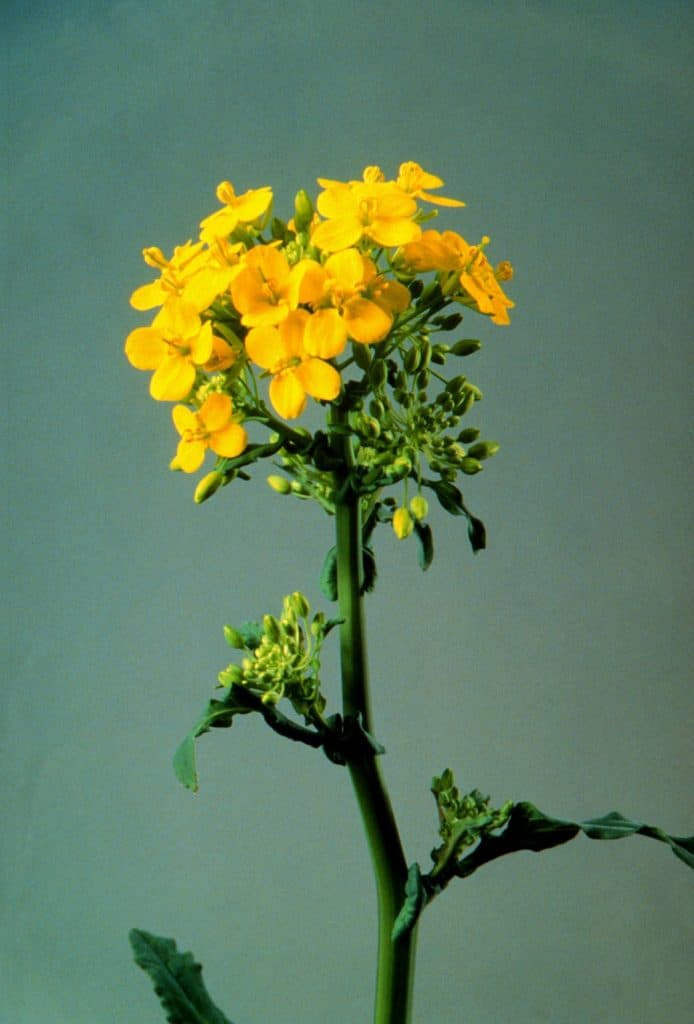
Polish type (B. rapaAlso referred to as Polish canola, it is the less commonly grown species of canola currently grown in Canada. More)
In 1936, a Shellbrook, SK farmer obtained rapeseed seed from a friend or relative in Poland. They grew this seed in their garden for a few years and found the plants to be well-adapted to their environment. However, at this time, there were no established markets in Canada for rapeseed. With the Second World War approaching, and the requirement for more information on rapeseed production, the Shellbrook farmer increased their seed supply and sold seed to neighbours. Due to the Polish origin of both the farmer and seed, the species they grew became known in Canada as “Polish” rapeseed. It was later established that this rapeseed belonged to the B. rapaAlso referred to as Polish canola, it is the less commonly grown species of canola currently grown in Canada. More species. Since seed of the B. rapaAlso referred to as Polish canola, it is the less commonly grown species of canola currently grown in Canada. More species was widely distributed at the outset of production, it dominated planted area for a few years. Yield tests showed that B. napusAlso referred to as Argentine canola, it is the species of canola currently commonly grown in Canada. More out yielded B. rapaAlso referred to as Polish canola, it is the less commonly grown species of canola currently grown in Canada. More. However, the earlier maturity and greater pod shatter resistance of B. rapaAlso referred to as Polish canola, it is the less commonly grown species of canola currently grown in Canada. More made it better adapted to short growing environments.
Canola quality B. junceaAlso referred to as brown mustard, it is a minor crop (from the Cruciferae or Brassicaceae plant family, commonly known as the mustard family) grown in Canada. More
The high Canola oil quality of B. junceaAlso referred to as brown mustard, it is a minor crop (from the Cruciferae or Brassicaceae plant family, commonly known as the mustard family) grown in Canada. More was developed through traditional breeding methods by Agriculture and Agri-Food CanadaAgriculture and Agri-Food Canada is a department of the Government of Canada. More (AAFCAgriculture and Agri-Food Canada is a department of the Government of Canada. More) at the Saskatoon Research Centre and Saskatchewan Wheat Pool (SWP). B. junceaAlso referred to as brown mustard, it is a minor crop (from the Cruciferae or Brassicaceae plant family, commonly known as the mustard family) grown in Canada. More is the same species used to produce oriental and brown mustard cultivarsCultivars are variants in a species developed through the intervention of humans (despite the term 'variety' often being incorrectly used to describe this). Cultivars can be open-pollinated type, hybrid, synthetic, composite, etc. More. In 2002, SWP introduced the first two cultivarsCultivars are variants in a species developed through the intervention of humans (despite the term 'variety' often being incorrectly used to describe this). Cultivars can be open-pollinated type, hybrid, synthetic, composite, etc. More, ‘Arid’ and ‘Amulet’, under contract production. This species is more suitable to the hotter, drier regions of the southern prairies and is best adapted to the brown soil zone. B. junceaAlso referred to as brown mustard, it is a minor crop (from the Cruciferae or Brassicaceae plant family, commonly known as the mustard family) grown in Canada. More pods do not shatter as easily as other canola cultivarsCultivars are variants in a species developed through the intervention of humans (despite the term 'variety' often being incorrectly used to describe this). Cultivars can be open-pollinated type, hybrid, synthetic, composite, etc. More and producers can harvest the crop without swathing it first.
Cultivar development
Cultivar development is a collaborative effort among plant breeders, pathologists, chemists, physiologists, and agronomists, as well as highly trained research technicians, biologists, and support staff. Plant breeders make crosses among promising genetic material, and select for desired seed yield, seed constituent concentrations (e.g. oil or protein, usually expressed as a percentage), and seed quality characteristics (e.g. the presence of specific amino acids and fatty acids). After several years of field testing, greenhouse testing, and the careful selection of genetics, promising lines are entered into private and public evaluation trials called Co-operative Tests that are located at over 20 locations across western Canada. After one year of testing in private trials, plus one to two years in the public Co-operative Tests, the lines that meet all required standards for oil quality, seed yield, and herbicide and disease tolerance are evaluated by the Western Canada Canola/Rapeseed Recommending Committee. Lines that meet the criteria of the Committee are recommended to the Canadian Food Inspection Agency for cultivar registration.
It requires eight to 10 years from the initial crosses until a cultivar is commercially registered. Rapeseed breeding began soon after the crop was introduced at AAFCAgriculture and Agri-Food Canada is a department of the Government of Canada. More Saskatoon. Other rapeseed breeding programs were initiated at the University of Manitoba in Winnipeg, MB in 1953 and at the University of Alberta, in Edmonton, AB in 1969 to develop more regionally adapted cultivarsCultivars are variants in a species developed through the intervention of humans (despite the term 'variety' often being incorrectly used to describe this). Cultivars can be open-pollinated type, hybrid, synthetic, composite, etc. More.
Rapeseed cultivars
The original seed supply of the B. napusAlso referred to as Argentine canola, it is the species of canola currently commonly grown in Canada. More species from Argentina contained a mixture of plant types and was not licensed. However, these seed stocks provided the genetic material for the development of Canadian B. napusAlso referred to as Argentine canola, it is the species of canola currently commonly grown in Canada. More cultivarsCultivars are variants in a species developed through the intervention of humans (despite the term 'variety' often being incorrectly used to describe this). Cultivars can be open-pollinated type, hybrid, synthetic, composite, etc. More. Similarly, B. rapaAlso referred to as Polish canola, it is the less commonly grown species of canola currently grown in Canada. More seeds originally from Poland were not licensed but were utilized in breeding programs for the development of cultivarsCultivars are variants in a species developed through the intervention of humans (despite the term 'variety' often being incorrectly used to describe this). Cultivars can be open-pollinated type, hybrid, synthetic, composite, etc. More later on.
Early breeding programs concentrated their efforts on improving agronomic characteristics and in oil concentration in the harvested seed. The first rapeseed cultivar licensed in Canada was released from AAFCAgriculture and Agri-Food Canada is a department of the Government of Canada. More Saskatoon:
- ‘Golden’ (1954) – a B. napusAlso referred to as Argentine canola, it is the species of canola currently commonly grown in Canada. More selection from Argentina with improved oil content and lodging tolerance (AAFCAgriculture and Agri-Food Canada is a department of the Government of Canada. More, Saskatoon)
- ‘Arlo’ (1958) – a B. rapaAlso referred to as Polish canola, it is the less commonly grown species of canola currently grown in Canada. More Swedish cultivar
- ‘Nugget’ (1961) – a B. napusAlso referred to as Argentine canola, it is the species of canola currently commonly grown in Canada. More selection from Argentina with improved oil content
- ‘Tanka’ (1963) – a B. napusAlso referred to as Argentine canola, it is the species of canola currently commonly grown in Canada. More selection from Golden with improved seed yield and seed size (University of Manitoba)
- ‘Echo’ (1964) – a B. rapaAlso referred to as Polish canola, it is the less commonly grown species of canola currently grown in Canada. More selection from Polish with improved seed yield (AAFCAgriculture and Agri-Food Canada is a department of the Government of Canada. More, Indian Head, SK)
- ‘Target’ (1966) – a B. napusAlso referred to as Argentine canola, it is the species of canola currently commonly grown in Canada. More selection from Tanka with improvements in maturity, plant height, oil content and seed yield (University of Manitoba)
- ‘Polar’ (1969) – a B. rapaAlso referred to as Polish canola, it is the less commonly grown species of canola currently grown in Canada. More selection from Polish with improved oil and protein content (University of Manitoba)
- ‘Turret’ (1970) – a B. napusAlso referred to as Argentine canola, it is the species of canola currently commonly grown in Canada. More selection from Target with improved maturity, oil content and seed yield (University of Manitoba)
Currently, there are over 100 cultivarsCultivars are variants in a species developed through the intervention of humans (despite the term 'variety' often being incorrectly used to describe this). Cultivars can be open-pollinated type, hybrid, synthetic, composite, etc. More registered for planting in Canada. Life science/seed companies continue to innovate and improve cultivarsCultivars are variants in a species developed through the intervention of humans (despite the term 'variety' often being incorrectly used to describe this). Cultivars can be open-pollinated type, hybrid, synthetic, composite, etc. More for pest resistance, lodging and pod shatter resistance, and suitable maturity for all environments in Canada, resulting in higher seed yield potential and reduced production risks for farmers who grow these cultivarsCultivars are variants in a species developed through the intervention of humans (despite the term 'variety' often being incorrectly used to describe this). Cultivars can be open-pollinated type, hybrid, synthetic, composite, etc. More.
Fatty acid profiles in edible oils
Edible vegetable oils are made up of fatty acids. The types of fatty acids determine whether a vegetable oil is used for edible or industrial purposes. Certain fatty acids, such as linoleic acid, are considered essential in human diets because they cannot be synthesized by the human body, but must be obtained from diet. All of the historic rapeseed cultivarsCultivars are variants in a species developed through the intervention of humans (despite the term 'variety' often being incorrectly used to describe this). Cultivars can be open-pollinated type, hybrid, synthetic, composite, etc. More listed above produced oil containing large concentrations of eicosenoic and erucic acids, which are not considered essential for human growth.
A comparison of current canola oil and other edible oils or dietary fats is shown in the table. More information on this is available at CanolaInfo.org.
Low erucic acid rapeseed (LEAR) cultivars
As early as 1956, the nutritional aspects of rapeseed oil were questioned, especially the high eicosenoic and erucic fatty acid contents. Canadian plant breeders responded quickly with isolation of rapeseed plants with low eicosenoic and erucic acid content-by 1960 for B. napusAlso referred to as Argentine canola, it is the species of canola currently commonly grown in Canada. More and 1964 for B. rapaAlso referred to as Polish canola, it is the less commonly grown species of canola currently grown in Canada. More. These desirable characteristics were then bred into suitable cultivarsCultivars are variants in a species developed through the intervention of humans (despite the term 'variety' often being incorrectly used to describe this). Cultivars can be open-pollinated type, hybrid, synthetic, composite, etc. More:
- ‘Oro’ (1968) – the first low erucic acid B. napusAlso referred to as Argentine canola, it is the species of canola currently commonly grown in Canada. More selection from crosses between Nugget and an unlicensed forage crop cultivar Liho, which contained low erucic acid (AAFCAgriculture and Agri-Food Canada is a department of the Government of Canada. More, Saskatoon)
- ‘Zephyr’ (1971) – a B. napusAlso referred to as Argentine canola, it is the species of canola currently commonly grown in Canada. More selection from an Oro X Target cross with improved oil and protein content (AAFCAgriculture and Agri-Food Canada is a department of the Government of Canada. More, Saskatoon)
- ‘Span’ (1971) – the first low erucic acid B. rapaAlso referred to as Polish canola, it is the less commonly grown species of canola currently grown in Canada. More cultivar developed from low erucic acid selections from Polish and Arlo (AAFCAgriculture and Agri-Food Canada is a department of the Government of Canada. More, Saskatoon)
- ‘Torch’ (1973) – a B. rapaAlso referred to as Polish canola, it is the less commonly grown species of canola currently grown in Canada. More selection from Span with improved seed yield (AAFCAgriculture and Agri-Food Canada is a department of the Government of Canada. More, Saskatoon)
- ‘Midas’ (1973) – a B. napusAlso referred to as Argentine canola, it is the species of canola currently commonly grown in Canada. More selection from crosses between Target and a low erucic acid source with seed yield equal to Target, but lower in protein content (AAFCAgriculture and Agri-Food Canada is a department of the Government of Canada. More, Saskatoon)
The development of low erucic cultivarsCultivars are variants in a species developed through the intervention of humans (despite the term 'variety' often being incorrectly used to describe this). Cultivars can be open-pollinated type, hybrid, synthetic, composite, etc. More represented significant improvement to seed quality and allowed Canada to first establish a maximum level of five per cent erucic acid in the oil component of the seed. Continual improvements in canola cultivarsCultivars are variants in a species developed through the intervention of humans (despite the term 'variety' often being incorrectly used to describe this). Cultivars can be open-pollinated type, hybrid, synthetic, composite, etc. More through plant breeding have allowed this maximum to be reduced to less than two per cent erucic acid, which is currently the global standard.
Low erucic acid and low glucosinolates canola cultivars
While rapeseed oil quality changes were being bred into suitable cultivarsCultivars are variants in a species developed through the intervention of humans (despite the term 'variety' often being incorrectly used to describe this). Cultivars can be open-pollinated type, hybrid, synthetic, composite, etc. More, plant breeders were also working with animal nutritionists to optimize meal quality for livestock consumption. Rapeseed meal is an excellent source of protein with a favourable balance of amino acids. However, the use of rapeseed meal in rations was limited by its glucosinolates content, which most plants of the mustard family contain. Glucosinolates are responsible for the pungent odour and taste, which ranges from the hot flavour in mustard seed and horseradish, to the more subtle flavours of rutabaga and cauliflower.
The glucosinolates in rapeseed led to inadequate palatability and nutritional content for livestock and poultry, resulting in reduced feed efficacy. For this reason, plant breeders searched for genetic material low in glucosinolates. In 1967, seeds from plants of the Polish cultivar ‘Bronowski’ were found to have a low concentration of glucosinolates. This genetic source for low glucosinolates concentration was then utilized to develop low erucic, low glucosinolates cultivarsCultivars are variants in a species developed through the intervention of humans (despite the term 'variety' often being incorrectly used to describe this). Cultivars can be open-pollinated type, hybrid, synthetic, composite, etc. More.
Dr. Baldur Stefansson of the University of Manitoba developed the first low erucic acid, low glucosinolate cultivar, ‘Tower’, in 1974 2, 3. The term “double low” is used to describe cultivarsCultivars are variants in a species developed through the intervention of humans (despite the term 'variety' often being incorrectly used to describe this). Cultivars can be open-pollinated type, hybrid, synthetic, composite, etc. More with low erucic acid and low glucosinolates levels. In 1977, the first double low Polish cultivar, ‘Candle’, was developed by Dr. Keith Downey of AAFCAgriculture and Agri-Food Canada is a department of the Government of Canada. More Saskatoon 2. Dr. Stefansson and Dr. Downey are known as the “Fathers of Canola” because of their incredibly important contributions to the agricultural industry. Canada became the first country in the world to produce large quantities of rapeseed with low erucic acid in the oil and low glucosinolates in the meal.
This new and improved quality in the seed, oil, and meal needed a name to distinguish the commodity from common rapeseed, and the name “canola”, derived from “Canadian oil”, was adopted.
Canola includes seeds of the genus Brassica (Brassica napusAlso referred to as Argentine canola, it is the species of canola currently commonly grown in Canada. More, Brassica rapaAlso referred to as Polish canola, it is the less commonly grown species of canola currently grown in Canada. More or Brassica junceaAlso referred to as brown mustard, it is a minor crop (from the Cruciferae or Brassicaceae plant family, commonly known as the mustard family) grown in Canada. More) from which the oil shall contain less than 2% erucic acid in its fatty acid profile and the solid component shall contain less than 30 micromoles of any one or any mixture of 3-butenyl glucosinolate, 4-pentenyl glucosinolate, 2-hydroxy-3 butenyl glucosinolate, and 2-hydroxy- 4-pentenyl glucosinolate per gram of air-dry, oil-free solid.
Except for specialty fatty acid cultivarsCultivars are variants in a species developed through the intervention of humans (despite the term 'variety' often being incorrectly used to describe this). Cultivars can be open-pollinated type, hybrid, synthetic, composite, etc. More like high erucic acid destined for specialty industrial markets, the cultivarsCultivars are variants in a species developed through the intervention of humans (despite the term 'variety' often being incorrectly used to describe this). Cultivars can be open-pollinated type, hybrid, synthetic, composite, etc. More registered in Canada must be of canola quality.
Canola oil quality B. junceaAlso referred to as brown mustard, it is a minor crop (from the Cruciferae or Brassicaceae plant family, commonly known as the mustard family) grown in Canada. More was developed by AAFCAgriculture and Agri-Food Canada is a department of the Government of Canada. More Saskatoon and Saskatchewan Wheat Pool by changing the fatty acid profile to that found in B. napusAlso referred to as Argentine canola, it is the species of canola currently commonly grown in Canada. More and B. rapaAlso referred to as Polish canola, it is the less commonly grown species of canola currently grown in Canada. More and reducing the erucic acid and glucosinolates levels to the canola standard.
Herbicide-tolerant canola plant
Through mutagenesis and gene transfer, plant breeders have developed canola cultivarsCultivars are variants in a species developed through the intervention of humans (despite the term 'variety' often being incorrectly used to describe this). Cultivars can be open-pollinated type, hybrid, synthetic, composite, etc. More that are tolerant to specific herbicides or groups of herbicides:
- Triazine-tolerant canola (TTC) was developed to allow growers to plant canola on fields infested with cruciferousPlants belonging to the family Brassicaceae or (previously referred to as) Cruciferae. More weeds such as wild mustard, stinkweed, ball mustard, to name a few. Many of these weeds cannot be controlled by herbicides in conventional herbicide systems. Unfortunately, the triazine resistance from the B. rapaAlso referred to as Polish canola, it is the less commonly grown species of canola currently grown in Canada. More weed (bird’s rape) is due to a cytoplasmic mutant, which meant that TTC cultivarsCultivars are variants in a species developed through the intervention of humans (despite the term 'variety' often being incorrectly used to describe this). Cultivars can be open-pollinated type, hybrid, synthetic, composite, etc. More yielded considerably less compared to conventional canola cultivarsCultivars are variants in a species developed through the intervention of humans (despite the term 'variety' often being incorrectly used to describe this). Cultivars can be open-pollinated type, hybrid, synthetic, composite, etc. More under weed-free conditions. Early work on triazine-tolerant canola took place at the University of Guelph, with the first B. napusAlso referred to as Argentine canola, it is the species of canola currently commonly grown in Canada. More cultivar, ‘OAC Triton’, registered in 1984.
- In 1995, the first imidazolinone-tolerant (Pursuit + Odyssey herbicides) B. napusAlso referred to as Argentine canola, it is the species of canola currently commonly grown in Canada. More cultivar ’45A71’ was registered. This cultivar and others contain a tolerance trait that was developed through mutagenesis by Cyanamid (now BASF).
- In 1995, the first transgenic B. napusAlso referred to as Argentine canola, it is the species of canola currently commonly grown in Canada. More cultivar, ‘Quest’, was registered. Quest is tolerant to the herbicide glyphosate (Roundup) and was developed by Monsanto (now Bayer).
- CultivarsCultivars are variants in a species developed through the intervention of humans (despite the term 'variety' often being incorrectly used to describe this). Cultivars can be open-pollinated type, hybrid, synthetic, composite, etc. More ‘Innovator’ and ‘Independence’ were granted registration in 1995. These transgenic B. napusAlso referred to as Argentine canola, it is the species of canola currently commonly grown in Canada. More cultivarsCultivars are variants in a species developed through the intervention of humans (despite the term 'variety' often being incorrectly used to describe this). Cultivars can be open-pollinated type, hybrid, synthetic, composite, etc. More were developed by Aventis (now Bayer) and contain a gene that provided resistance to the herbicide glufosinate ammonium (Liberty).
- In 1999, several bromoxynil-resistant cultivars-‘295 BX’, ‘Armor BX’, and ‘Zodiac BX’-were developed by the University of Manitoba.
From 1995 to 2001, over 100 herbicide-tolerant cultivarsCultivars are variants in a species developed through the intervention of humans (despite the term 'variety' often being incorrectly used to describe this). Cultivars can be open-pollinated type, hybrid, synthetic, composite, etc. More have been recommended for registration.
Hybrids and synthetics
A canola hybrid is the result of crossbreeding two lines of canola. Research in greenhouses have showed that making hand crosses between two distantly related lines of canola resulted in seed yield up to 45 per cent higher than either parent line when grown to maturity on their own. This increase in seed yield is the result of heterosis or hybrid vigourSeed properties that determine the potential for rapid uniform emergence and development of normal seedlings under a wide range of field conditions. More. The more distantly related the parents, the greater the hybrid vigourSeed properties that determine the potential for rapid uniform emergence and development of normal seedlings under a wide range of field conditions. More of their progeny. However, producing hybrid seed by hand for large volumes of seed is economically impractical. Since B. napusAlso referred to as Argentine canola, it is the species of canola currently commonly grown in Canada. More cultivarsCultivars are variants in a species developed through the intervention of humans (despite the term 'variety' often being incorrectly used to describe this). Cultivars can be open-pollinated type, hybrid, synthetic, composite, etc. More are mainly self-pollinated, the self-pollination of the parent lines must be controlled to make hybridization commercially feasible.
To date, several approaches have been taken to develop hybridization systems in B. napusAlso referred to as Argentine canola, it is the species of canola currently commonly grown in Canada. More. The first relatively successful programs utilized traditional hybrid breeding methods such as cytoplasmic male sterility (CMS). Researchers discovered that some Brassica species and close relatives had male-sterile cytoplasm (material surrounding the nucleus of a cell). At the cellular level, fertility is controlled by an interaction between the cell nucleus and cytoplasm. The CMS systems for canola hybridization depend upon this mutation in certain cytoplasmic bodies that result in failure to develop functional pollen or anthers. Use of CMS allowed canola breeders to produce canola female plants that either fail to make pollen, fail to shed pollen or make pollen that is unable to cause self-fertilization. The hybrid system is normally composed of three components- a male-sterile Line A, a maintainer Line B and a restorer Line R (Figure 2).
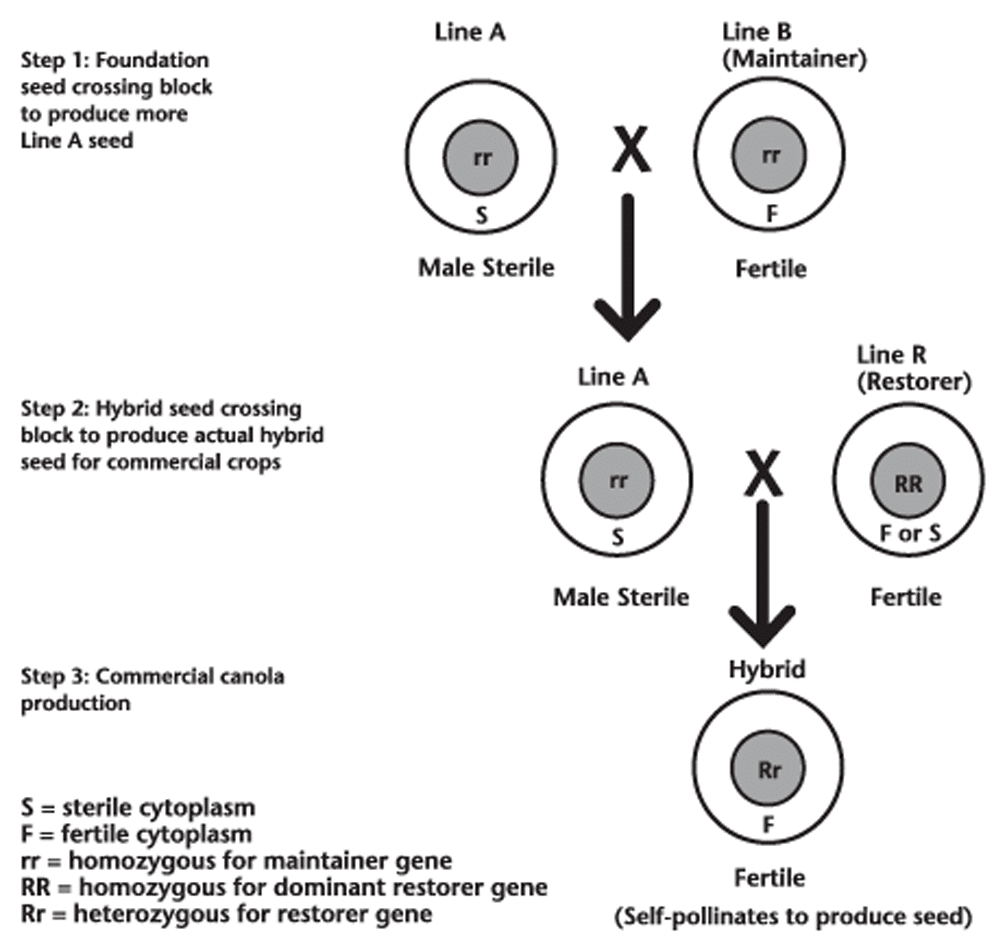
Female plant flowers from Line A have a sterile cytoplasm and do not produce pollen and cannot self-pollinate. This CMS characteristic is inherited maternally. Therefore, when a CMS female Line A, is crossed with a genetically identical maintainer Line B that produces pollen, all the seed produced retains the CMS trait. The restorer Line R is genetically different from Line A and contains nuclear genes that compensate for the defect in the cytoplasm and restore fertility to the hybrid cross. The first commercial CMS B. napusAlso referred to as Argentine canola, it is the species of canola currently commonly grown in Canada. More hybrid, ‘Hyola 40’, was registered in 1989 by Advanta Seeds. This was quickly followed by the very popular hybrid ‘Hyola 401’ in 1991.
A novel hybridization system was developed by Plant Genetic Systems in Belgium through biotechnology. This system involves the use of two parental lines.
The first parental line is male sterile and does not produce viable pollen grains and cannot self-pollinate. A gene isolated from a common soil bacterium and inserted into the parental line causes this nuclear male sterility. The gene controls production of a specific enzyme in a specific anther cell layer and at a specific stage of anther development resulting in no pollen production.
The second parental line contains another gene, obtained from the same common soil bacterium that produces an inhibitor enzyme that counteracts the sterility enzyme in the first parental line to restore fertility. A gene that confers tolerance to the herbicide glufosinate ammonium (Liberty) was inserted into both parental lines. When the two lines are crossed, the progeny is a 100 per cent true hybrid. And since fertility is restored, the hybrid plants are fully fertile and produce seed. The first Liberty-tolerant hybrids (called ‘3850’ and ‘3880’) were registered in 1996 by Aventis (which became part of Bayer CropScience and is now BASF).
Hybrid breeding techniques, while reasonably successful in B. napusAlso referred to as Argentine canola, it is the species of canola currently commonly grown in Canada. More, have not been successful in B. rapaAlso referred to as Polish canola, it is the less commonly grown species of canola currently grown in Canada. More cultivar development. An alternative breeding method to exploit the heterosis available in the Brassica family is the production of “synthetic” cultivarsCultivars are variants in a species developed through the intervention of humans (despite the term 'variety' often being incorrectly used to describe this). Cultivars can be open-pollinated type, hybrid, synthetic, composite, etc. More. Synthetic canola cultivarsCultivars are variants in a species developed through the intervention of humans (despite the term 'variety' often being incorrectly used to describe this). Cultivars can be open-pollinated type, hybrid, synthetic, composite, etc. More are developed by blending seed from one parent with seed from another parent and growing out the mixed seed to produce a Certified synthetic seed (Figure 3).
Synthetics of B. rapaAlso referred to as Polish canola, it is the less commonly grown species of canola currently grown in Canada. More are usually composed of two, or at most three, parental lines. The resulting Certified synthetic seed composed of a mixture of hybrid and parental plants tends to be more stable over a wider range of environmental conditions than conventional cultivarsCultivars are variants in a species developed through the intervention of humans (despite the term 'variety' often being incorrectly used to describe this). Cultivars can be open-pollinated type, hybrid, synthetic, composite, etc. More. In comparison, a synthetic canola cultivar is usually intermediate between conventional cultivarsCultivars are variants in a species developed through the intervention of humans (despite the term 'variety' often being incorrectly used to describe this). Cultivars can be open-pollinated type, hybrid, synthetic, composite, etc. More and hybrids in terms of capturing heterosis. B. rapa canola is self-incompatible, meaning the plant cannot self-pollinate with pollen from a flower on the same plant, but must pollinate with other plants in the field. This self-incompatibility in B. rapaAlso referred to as Polish canola, it is the less commonly grown species of canola currently grown in Canada. More is an advantage in making synthetic cultivarsCultivars are variants in a species developed through the intervention of humans (despite the term 'variety' often being incorrectly used to describe this). Cultivars can be open-pollinated type, hybrid, synthetic, composite, etc. More. The first B. rapaAlso referred to as Polish canola, it is the less commonly grown species of canola currently grown in Canada. More synthetic cultivarsCultivars are variants in a species developed through the intervention of humans (despite the term 'variety' often being incorrectly used to describe this). Cultivars can be open-pollinated type, hybrid, synthetic, composite, etc. More, ‘Hysyn 100’ and ‘Hysyn 110’, were registered in 1994 by Advanta Seeds.
Synthetics of B. napusAlso referred to as Argentine canola, it is the species of canola currently commonly grown in Canada. More are developed from two or more parental lines, which are then mixed in equal proportions (although not always) and grown in isolation. As B. napusAlso referred to as Argentine canola, it is the species of canola currently commonly grown in Canada. More is self-compatible and the degree of outcrossing is dependent on insect pollination, there will be varying degrees of crossing between the parental lines. The seed of the next generation will be a mixture of the parental lines and all possible hybrids between them. For example, a three parent synthetic would include the original three parental lines and the three possible hybrids. This process can be continued for another generation before the seed is released as Certified. As the degree of outcrossing is variable, it is difficult to predict what levels of heterosis will be achieved in the commercial seed. The first synthetic B. napusAlso referred to as Argentine canola, it is the species of canola currently commonly grown in Canada. More cultivar registered in Canada was ‘Synbrid 220’ in 1997. The success of hybridization to exploit heterosis and yield gain has removed B. napusAlso referred to as Argentine canola, it is the species of canola currently commonly grown in Canada. More synthetic lines from commercial production.
Winter canola cultivars
Winter (fall-seeded) rapeseed is widely grown in parts of Europe and Asia. The term rapeseed is used, but many of the cultivarsCultivars are variants in a species developed through the intervention of humans (despite the term 'variety' often being incorrectly used to describe this). Cultivars can be open-pollinated type, hybrid, synthetic, composite, etc. More have similar erucic acid and glucosinolate content to Canadian cultivarsCultivars are variants in a species developed through the intervention of humans (despite the term 'variety' often being incorrectly used to describe this). Cultivars can be open-pollinated type, hybrid, synthetic, composite, etc. More and fit the canola definition. Winter rapeseed greatly out yields spring rapeseed as shown by Swedish yield data (Table 2).
| Table 2. Average yield in Sweden of four types of rapeseed |
Early winter cultivarsCultivars are variants in a species developed through the intervention of humans (despite the term 'variety' often being incorrectly used to describe this). Cultivars can be open-pollinated type, hybrid, synthetic, composite, etc. More introduced and registered in Canada were of European origin. Since they did not meet the standards for glucosinolates, they were rapeseed cultivarsCultivars are variants in a species developed through the intervention of humans (despite the term 'variety' often being incorrectly used to describe this). Cultivars can be open-pollinated type, hybrid, synthetic, composite, etc. More. However, later breeding work in Europe and eastern Canada produced winter canola cultivarsCultivars are variants in a species developed through the intervention of humans (despite the term 'variety' often being incorrectly used to describe this). Cultivars can be open-pollinated type, hybrid, synthetic, composite, etc. More. The first Canadian-bred winter canola, ‘OAC Winfield’, was developed by the University of Guelph, in Guelph, ON and registered in 1988. In western Canada, winter canola is not grown commercially because of unsatisfactory winter hardiness of the plant and the cold winters experienced on the Prairies. An occasional crop of a cultivar with adequate winter hardiness may survive some winters in the southern prairies but attempts to grow it consistently have failed. Winter canola is slightly less winter hardy than winter barley, which also rarely survives Prairie winters. A significant increase in winter hardiness is required for successful production in western Canada. CultivarsCultivars are variants in a species developed through the intervention of humans (despite the term 'variety' often being incorrectly used to describe this). Cultivars can be open-pollinated type, hybrid, synthetic, composite, etc. More with this degree of winter hardiness have not likely been observed to date anywhere in the world.
Research trials by the University of Guelph have shown that winter canola has limited potential for some areas of Ontario. Where winter canola successfully overwinters, it will outyield spring canola by 40 to 50 per cent. Management studies at locations throughout Ontario have shown that winter canola has the best chance of winter survival and high seed yield when grown on well-drained, lighter-textured loam soils and on sandy loam soils in southern Ontario with adequate snow cover. Winter survival is not very good on heavy clay soils or soils with poor drainage due to heaving.
Specialty fatty acid cultivars
Canola oil is accepted around the world as a healthy oil low in saturated fat. However, there are markets available for oils with specific oil characteristics for special functions. Specialty fatty acid canola cultivarsCultivars are variants in a species developed through the intervention of humans (despite the term 'variety' often being incorrectly used to describe this). Cultivars can be open-pollinated type, hybrid, synthetic, composite, etc. More are tested and recommended for registration by the Specialty and Contract Registration Committee, a sub-committee of the Western Canada Canola/Rapeseed Recommending Committee. Specialty cultivarsCultivars are variants in a species developed through the intervention of humans (despite the term 'variety' often being incorrectly used to describe this). Cultivars can be open-pollinated type, hybrid, synthetic, composite, etc. More are restricted to contract production through private companies.
High erucic acid rapeseed (HEAR)
Prior to the reduction in erucic acid levels which produced canola, rapeseed oil was used both for edible and industrial purposes. The high levels of erucic acid made the oil useful in the production of lubricants. Today there remains a market for a significant amount of high erucic acid rapeseed oil for use in plastics, lubricants, lacquers and detergents.
Plant breeders increased the erucic acid level in conventional rapeseed to produce high erucic acid rapeseed (HEAR). At the same time, they reduced the glucosinolate levels so that the meal from HEAR cultivarsCultivars are variants in a species developed through the intervention of humans (despite the term 'variety' often being incorrectly used to describe this). Cultivars can be open-pollinated type, hybrid, synthetic, composite, etc. More was more readily marketable as a livestock feed. The first HEAR (B. rapaAlso referred to as Polish canola, it is the less commonly grown species of canola currently grown in Canada. More) cultivar, ‘R-500’, was developed at the AAFCAgriculture and Agri-Food Canada is a department of the Government of Canada. More Saskatoon, SK Research Centre. It produced a high glucosinolate meal. The second HEAR (B. napusAlso referred to as Argentine canola, it is the species of canola currently commonly grown in Canada. More) cultivar, ‘Reston’, was registered in 1982 by the University of Manitoba, in Winnipeg, MB. It contained 40 to 48 per cent erucic acid and medium glucosinolate levels. It was de-registered in 1989. Since then, many HEAR cultivarsCultivars are variants in a species developed through the intervention of humans (despite the term 'variety' often being incorrectly used to describe this). Cultivars can be open-pollinated type, hybrid, synthetic, composite, etc. More have been developed and released by the University of Manitoba.
Low linolenic and low linolenic/High oleic canola
Plant breeders also recognized that by manipulating other fatty acids, different nutrient and processing characteristics could be produced in the resulting oil. The first cultivar in this category was developed at the University of Manitoba and registered in 1987 under the name ‘Stellar’. Stellar had a reduced linolenic fatty acid content (three per cent), which resulted in significant improvements in the processing and keeping quality of the oil. High linolenic acid makes oil go rancid. Since Stellar, companies such as Cargill Specialty Canola Oils and Corteva have registered cultivarsCultivars are variants in a species developed through the intervention of humans (despite the term 'variety' often being incorrectly used to describe this). Cultivars can be open-pollinated type, hybrid, synthetic, composite, etc. More with modified fatty acid profiles, such as high oleic, low linolenic, or high oleic and low linolenic.
Further developments of canola seed
Over the past decade cultivarsCultivars are variants in a species developed through the intervention of humans (despite the term 'variety' often being incorrectly used to describe this). Cultivars can be open-pollinated type, hybrid, synthetic, composite, etc. More have changed rapidly as new quality and desired agronomic characteristics have been established. If Canadian canola plant breeders are to continue to be successful in the development of cultivarsCultivars are variants in a species developed through the intervention of humans (despite the term 'variety' often being incorrectly used to describe this). Cultivars can be open-pollinated type, hybrid, synthetic, composite, etc. More optimal for production in the Prairies, there needs to be cultivar improvements.
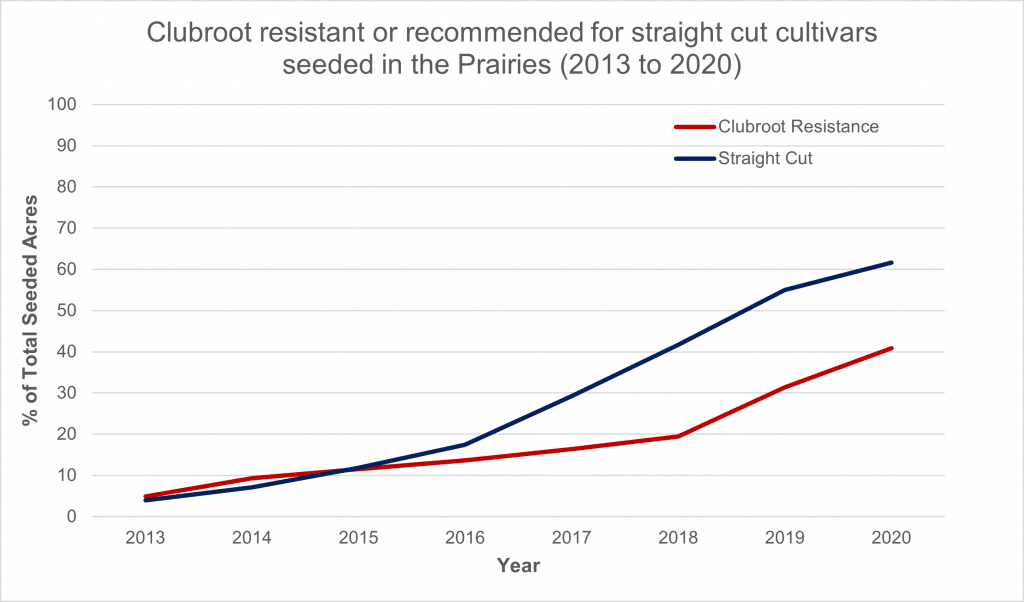
Note – Prairies includes Manitoba, Saskatchewan and Alberta;
Total seeded acreage only includes hybrids seeded to over 10,000 acres (including the non-specified category);
Cultivars recommended for straight cut are based on the latest recommendation (as of spring 2021)
Potential cultivar improvements that plant breeders are working toward (or continue to improve on) include:
- tolerance to drought stress
- tolerance to excess moisture stress
- frost tolerance (late spring and early fall frosts)
- elimination of green seed
- improved nutrient use efficiency
- even lower saturated fatty acid content
- early maturing B. napusAlso referred to as Argentine canola, it is the species of canola currently commonly grown in Canada. More for shorter growing environments
- new herbicide tolerance
- disease resistance – ex. to clubroot, blackleg, sclerotinia, verticillium stripe, etc.
- insect resistance – ex. to flea beetle, root maggot, cabbage seedpod weevil, etc.
- cold temperature seedling tolerance for improved germination and emergence
- higher yielding hybrids
- pod drop and pod shatter resistance
- increased and improved disease resistance to sclerotinia, blackleg, verticillium stripe, and clubroot
Footnotes
- Nagaharu, U. 1935. Genome Analysis with special reference to the experimental formation of B. napusAlso referred to as Argentine canola, it is the species of canola currently commonly grown in Canada. More and particular mode of fertilization. Jpn J Bot., 389-452.
- Daun, J.K., Eskin, N.A.M., & Hickling, D. 2011. Canola – Chemistry, Production, Processing and Utilization. AOCS Press. Available at: app.knovel.com/hotlink/toc/id:kpCCPPU001/canola-chemistry-production/canola-chemistry-production [2021 Apr. 9].
- Stefansson, B.R., and Kondra, Z.P. 1975. Tower Summer Rape. Can. J. Plant Sci., 344, 343–344.
